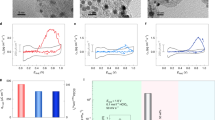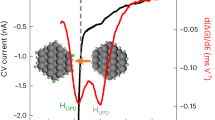Abstract
Electrocatalysis is at the heart of our future transition to a renewable energy system. Most energy storage and conversion technologies for renewables rely on electrocatalytic processes and, with increasing availability of cheap electrical energy from renewables, chemical production will witness electrification in the near future1,2,3. However, our fundamental understanding of electrocatalysis lags behind the field of classical heterogeneous catalysis that has been the dominating chemical technology for a long time. Here, we describe a new strategy to advance fundamental studies on electrocatalytic materials. We propose to ‘electrify’ complex oxide-based model catalysts made by surface science methods to explore electrocatalytic reactions in liquid electrolytes. We demonstrate the feasibility of this concept by transferring an atomically defined platinum/cobalt oxide model catalyst into the electrochemical environment while preserving its atomic surface structure. Using this approach, we explore particle size effects and identify hitherto unknown metal–support interactions that stabilize oxidized platinum at the nanoparticle interface. The metal–support interactions open a new synergistic reaction pathway that involves both metallic and oxidized platinum. Our results illustrate the potential of the concept, which makes available a systematic approach to build atomically defined model electrodes for fundamental electrocatalytic studies.
This is a preview of subscription content, access via your institution
Access options
Access Nature and 54 other Nature Portfolio journals
Get Nature+, our best-value online-access subscription
$29.99 / 30 days
cancel any time
Subscribe to this journal
Receive 12 print issues and online access
$259.00 per year
only $21.58 per issue
Buy this article
- Purchase on Springer Link
- Instant access to full article PDF
Prices may be subject to local taxes which are calculated during checkout



Similar content being viewed by others
References
Seh, Z. W. et al. Combining theory and experiment in electrocatalysis: Insights into materials design. Science 355, 146 (2017).
Stamenkovic, V. R., Strmcnik, D., Lopes, P. P. & Markovic, N. M. Energy and fuels from electrochemical interfaces. Nat. Mater. 16, 57–69 (2017).
Katsounaros, I., Cherevko, S., Zeradjanin, A. R. & Mayrhofer, K. J. J. Oxygen electrochemistry as a cornerstone for sustainable energy conversion. Angew. Chem. Int. Ed. 53, 102–121 (2014).
Ertl, G. Reactions at surfaces: From atoms to complexity (Nobel lecture). Angew. Chem. Int. Ed. 47, 3524–3535 (2008).
Rodriguez, J. A. et al. Activity of CeO x and TiO x nanoparticles grown on Au(111) in the water-gas shift reaction. Science 318, 1757–1760 (2007).
Schauermann, S., Nilius, N., Shaikhutdinov, S. & Freund, H. J. Nanoparticles for heterogeneous catalysis: new mechanistic insights. Acc. Chem. Res. 46, 1673–1681 (2013).
Lykhach, Y. et al. Counting electrons on supported nanoparticles. Nat. Mater. 15, 284–288 (2016).
Weaver, M. J. & Gao, X. P. In-situ electrochemical surface science. Annu. Rev. Phys. Chem. 44, 459–494 (1993).
Kolb, D. M. Electrochemical surface science: past, present and future. J. Solid State Electrochem. 15, 1391–1399 (2011).
Koper, M. T. M. Structure sensitivity and nanoscale effects in electrocatalysis. Nanoscale 3, 2054–2073 (2011).
Clavilier, J., Faure, R., Guinet, G. & Durand, R. Preparation of mono-crystalline Pt microelectrodes and electrochemical study of the plane surfaces cut in the direction of the (111) and (110) planes. J. Electroanal. Chem. 107, 205–209 (1980).
Stamenkovic, V. R. et al. Surface chemistry on bimetallic alloy surfaces: adsorption of anions and oxidation of CO on Pt3Sn(111). J. Am. Chem. Soc. 125, 2736–2745 (2003).
Schnaidt, J. et al. A combined UHV-STM-flow cell set-up for electrochemical/electrocatalytic studies of structurally well-defined UHV prepared model electrodes. Phys. Chem. Chem. Phys. 19, 4166–4178 (2017).
Mercer, M. P. & Hoster, H. E. Ultrahigh vacuum and electrocatalysis - the powers of quantitative surface imaging. Nano Energy 29, 394–413 (2016).
Ardizzone, S. & Trasatti, S. Interfacial properties of oxides with technological impact in electrochemistry. Adv. Colloid Interface Sci. 64, 173–251 (1996).
Müllner, M., Balajka, J., Schmid, M., Diebold, U. & Mertens, S. F. L. Self-limiting adsorption of WO3 oligomers on oxide substrates in solution. J. Phys. Chem. C 121, 19743–19750 (2017).
Liang, Y. Y. et al. Co3O4 nanocrystals on graphene as a synergistic catalyst for oxygen reduction reaction. Nat. Mater. 10, 780–786 (2011).
Bruix, A. et al. Maximum noble-metal efficiency in catalytic materials: atomically dispersed surface platinum. Angew. Chem. Int. Ed. 53, 10525–10530 (2014).
Meyer, W., Biedermann, K., Gubo, M., Hammer, L. & Heinz, K. Surface structure of polar Co3O4(111) films grown epitaxially on Ir(100)-(1x1). J. Phys. Condens. Matter 20, 265011 (2008).
Chivot, J., Mendoza, L., Mansour, C., Pauporte, T. & Cassir, M. New insight in the behaviour of Co-H2O system at 25-150 degrees C, based on revised Pourbaix diagrams. Corros. Sci. 50, 62–69 (2008).
Freund, H.-J., Meijer, G., Scheffler, M., Schlögl, R. & Wolf, M. CO oxidation as a prototypical reaction for heterogeneous processes. Angew. Chem. Int. Ed. 50, 10064–10094 (2011).
Liu, H. S. et al. A review of anode catalysis in the direct methanol fuel cell. J. Power Sources 155, 95–110 (2006).
Tushaus, M., Schweizer, E., Hollins, P. & Bradshaw, A. M. Yet another vibrational study of the adsorption system Pt(111)-Co. J. Electron Spectrosc. Relat. Phenom. 44, 305–316 (1987).
Brummel, O. et al. Stabilization of small platinum nanoparticles on Pt-CeO2 thin film electrocatalysts during methanol oxidation. J. Phys. Chem. C. 120, 19723–19736 (2016).
Garcia, G., Rodriguez, P., Rosca, V. & Koper, M. T. M. Fourier transform infrared spectroscopy study of CO electro-oxidation on Pt(111) in alkaline media. Langmuir 25, 13661–13666 (2009).
Stamenkovic, V., Chou, K. C., Somorjai, G. A., Ross, P. N. & Markovic, N. M. Vibrational properties of CO at the Pt(111)-solution interface: the anomalous stark-tuning slope. J. Phys. Chem. B 109, 678–680 (2005).
Brummel, O. et al. Structural transformations and adsorption properties of PtNi nanoalloy thin film electrocatalysts prepared by magnetron co-sputtering. Electrochim. Acta 251, 427–441 (2017).
Ferstl, P. et al. Adsorption and activation of CO on Co3O4(111) thin films. J. Phys. Chem. C 119, 16688–16699 (2015).
Fester, J., Sun, Z., Rodríguez-Fernández, J., Walton, A. & Lauritsen, J. V. Phase transitions of cobalt oxide bilayers on Au(111) and Pt(111): the role of edge sites and substrate interactions. J. Phys. Chem. B 122, 561–571 (2018).
Parkinson, G. S. et al. Carbon monoxide-induced adatom sintering in a Pd-Fe3O4 model catalyst. Nat. Mater. 12, 724–728 (2013).
Biedermann, K., Gubo, M., Hammer, L. & Heinz, K. Phases and phase transitions of hexagonal cobalt oxide films on Ir(100)-(1 × 1). J. Phys. Condens. Matter 21, 185003 (2009).
Meyer, W., Biedermann, K., Gubo, M., Hammer, L. & Heinz, K. Surface structure of polar Co3O4(111) films grown epitaxially on Ir(100)-(1 × 1). J. Phys. Condens. Matter 20, 265011 (2008).
Ferstl, P. et al. Structure and ordering of oxygen on unreconstructed Ir(100). Phys. Rev. B 93, 235406 (2016).
Libra J. KolXPD: Software for spectroscopy data measurement and processing, http://www.kolibrik.net/science/kolxpd/, Kolibrik.net, s.r.o., Žďár nad Sázavou, Czech Republic.
Gomez, R. & Weaver, M. J. Electrochemical infrared studies of monocrystalline iridium surfaces. Part 2: carbon monoxide and nitric oxide adsorption on Ir(110). Langmuir 14, 2525–2534 (1998).
Klemm, S. O., Topalov, A. A., Laska, C. A. & Mayrhofer, K. J. J. Coupling of a high throughput microelectrochemical cell with online multielemental trace analysis by ICP-MS. Electrochem. Commun. 13, 1533–1535 (2011).
Schuppert, A. K., Topalov, A. A., Katsounaros, I., Klemm, S. O. & Mayrhofer, K. J. J. A scanning flow cell system for fully automated screening of electrocatalyst materials. J. Electrochem. Soc. 159, F670–F675 (2012).
Acknowledgements
The authors acknowledge financial support by the Deutsche Forschungsgemeinschaft (DFG) within the Cluster of Excellence ‘Engineering of Advanced Materials’ (project EXC 315) (Bridge Funding) and further projects. Additional support by the DFG is acknowledged within the Research Unit FOR 1878 ‘Functional Molecular Structures on Complex Oxide Surfaces’. Furthermore, the authors acknowledge the CERIC-ERIC Consortium for the access to experimental facilities and financial support. N.T., T.S., B.Š. and V.M. acknowledge the infrastructure project no. CZ.02.1.01/0.0/0.0/16_013/0001788 and LM2015057 for the support of the SPL−MSB facility.
Author information
Authors and Affiliations
Contributions
F.F., C.S., M.B. and F.W. prepared the samples, performed the EC-IRRAS and CV measurements and analysed the data. M.B., S.C., S.G. and O.K. performed SFC experiments and analysed the data. Y.L., M.V., B.Š., T.S., N.T., A.N., K.B., K.C.P. and O.B. performed the SR-XPS experiments and the combined electrochemical and XPS experiments and analysed the data. M.B., T.W. and R.S. performed the UHV IRRAS experiments. F.X., F.F., M.A., C.S. and M.A.S. performed the STM experiments and analysed the data. V.M., K.J.J.M., O.B. and J.L. supervised the experimental work and analysed the data. J.L., Y.L. and O.B. prepared the manuscript with the support of the other co-authors.
Corresponding authors
Ethics declarations
Competing interests
The authors declare no competing interests.
Additional information
Publisher’s note: Springer Nature remains neutral with regard to jurisdictional claims in published maps and institutional affiliations.
Supplementary information
Supplementary Information
Supplementary Information, Supplementary Figures 1–8, Supplementary References 1–10
Rights and permissions
About this article
Cite this article
Faisal, F., Stumm, C., Bertram, M. et al. Electrifying model catalysts for understanding electrocatalytic reactions in liquid electrolytes. Nature Mater 17, 592–598 (2018). https://doi.org/10.1038/s41563-018-0088-3
Received:
Accepted:
Published:
Issue Date:
DOI: https://doi.org/10.1038/s41563-018-0088-3
This article is cited by
-
Comparative study of Co3O4(111), CoFe2O4(111), and Fe3O4(111) thin film electrocatalysts for the oxygen evolution reaction
Nature Communications (2023)
-
Combination of a reaction cell and an ultra-high vacuum system for the in situ preparation and characterization of a model catalyst
Nuclear Science and Techniques (2023)
-
Structural transformations of solid electrocatalysts and photocatalysts
Nature Reviews Chemistry (2021)
-
Favorable anion adsorption/desorption of high rate NiSe2 nanosheets/hollow mesoporous carbon for battery-supercapacitor hybrid devices
Nano Research (2021)
-
Application of Scanning Tunneling Microscopy in Electrocatalysis and Electrochemistry
Electrochemical Energy Reviews (2021)



